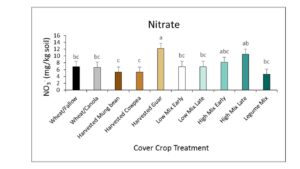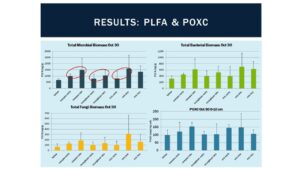Final report for LS16-271
Project Information
Soil health has received increasing interest in recent years and cover cropping has been a management tool encouraged to expedite recovery of soil function in degraded cropping systems. However, adoption of soil health promoting practices such as cover crops has been hindered in water-limited environments due to potential depletion of soil water resources and subsequent decline in cash crop yields. Some producers have questioned the feasibility of using double crops instead of cover crops, as double crops could provide an economic return. Our main objective was to evaluate cover crop and double crop options in continuous wheat systems within the water-limited environment of the Texas Rolling Plains. Four study locations in the Texas Rolling Plains were utilized, of which three were conducted on-farm. We hypothesized that double crops could provide similar benefits of cover crops with an opportunity for additional profit. We comparing traditional wheat cropping systems (summer fallow) with rotational options (canola), cover crop options (mixed cover crop species at two different rates and termination timings), and double crop options (mungbeans, cowpeas, pigeon peas, and guar). Success of summer cropping programs varied by location. Two of four locations endured at least on failure of summer crops due to drought conditions. In addition, the wheat crop also failed at two locations due to persisting drought conditions. During one of three summers, guar and mungbean were shown to produce a viable grain crop without hindering subsequent wheat yields. At some locations, the double crop provided the greatest economic return as the subsequent wheat crop (fallow or summer crop) failed due to lack of fall moisture and stand establishment. Across all on-farm locations, wheat yield or forage production was not statistically different among treatments. If adequate fall precipitation was recorded, stored soil water did not differ among treatments at time of wheat planting as soil water deficit due to summer crop use was recovered with enhanced soil water capture and storage. Microbial analysis of soil using PLFA did not show any significant effect due to treatment during the project, which may be a result of lack of short-term effects on sites that had a long history of good no-till management. In-season precipitation proved most critical in success of crop growth, rather cover crop, double crop, or the wheat cash crop. The cost of the cover crops would be difficult to recover, as net returns of traditional wheat systems are in the region are marginal. Cost share programs could offset such costs, but crop insurance is not currently available in the region when systems are intensified using double crops. Integrating cattle to utilize summer forage could potentially offset costs and enhance soil health, which warrants future research and demonstration.
Objectives
- Evaluate the effect of intensified cropping systems in a predominantly monoculture wheat producing region that will promote soil health and water conservation while maintaining agronomic profitability and environmental sustainability; and
- Determine and disseminate the most effective best management systems that promote economic profitability and environmental sustainability while protecting natural resources.
Performance Targets
1) Identify and meet with on-farm collaborators; 2) select on-farm demonstration sites; 3) select treatments for each location; 4) establish cover crop and double crop treatments; 5) measure initial soil parameters; 6) measure soil moisture storage; 7) establish cash crop wheat crops.
Cooperators
- - Producer
- - Producer
- - Producer
- (Educator)
- (Researcher)
- (Researcher)
Research
Three producers were identified in three counties: Archer, Wichita, and Wilbarger, in which research demonstration sites were ultimately placed. At time of selection, each site was cropped to winter wheat and had been under no-till production for at least 8 years. Soils as each consisted of Kamay silt loam (Archer); Winters loam (Wichita); Tipton loam (Wilbarger). These three sites complemented the university site located at the Texas A&M AgriLife Research and Extension Center at Vernon (Vernon site). The Vernon site consisted of Miles sandy loam soils. Each on-farm location had the following treatments: 1) continuous wheat with fallow summer; 2) wheat/canola rotation with fallow summer; and continuous wheat with 3) mixed species cover crop planted at 15 lb/ac and terminated at 55-70 days; 4) mixed species cover crop planted at 20 lb/ac and terminated at 55-70 days; 5) mixed species cover crop planted at 15 lb/ac and terminated at 75-90 days; 6) mixed species cover crop planted at 20 lb/ac and terminated at 75-90 days; 7) broadleaf mixed species cover crop planted at 20 lb/ac and terminated at 55-70 days; 8) guar; and 9) mungbeans. The Wilbarger and Wichita Country also have black-eyed cowpeas and the Archer and Wichita County sites have pigeon peas. The guar, mungbeans, cowpeas, and pigeon peas were planted as double crops. All of these treatments are evaluated at the Vernon site, with each treatment evaluated as a cover crop and a double crop. The mixed species cover crops include mungbeans, guar, cowpeas, forage sorghum, pearl millet, proso millet, foxtail millet, buckwheat, and sunflower. The broadleaf mix consisted of cowpeas, mungbeans, guar, buckwheat, and sunflower. At the Archer County site, a cool-season mixed species is planted followed the warm-season mixed cover crop and compared to forage production of wheat following the same summer treatments.
The low cover crop mix was planted at a rate of 15 lb/ac for the on-farm locations and consisted of: forage cowpea (3 lb/ac); mungbeans (3); guar (2); forage sorghum (1); pearl millet (2); proso millet (1); foxtail millet (1); buckwheat (1); and sunflower (1). The high cover crop mix was planted at a rate of 20 lb/ac consisting of: forage cowpea (3); mungbeans (3); guar (3); forage sorghum (2); pearl millet (3); proso millet (2); foxtail millet (2); buckwheat (1); and sunflower (1). These rates and mixes were similar to those used and recommended by local NRCS field office personnel, thus represented what a farmer may actually plant if using cost share programs through NRCS or using NRCS guidelines in general. The broadleaf cover crop mix was planted to allow in-season herbicide applications to control summer weedy grasses if needed. Sumer annual grasses were expressed as a concern by producers and the advisory panel prior to initiating the project. The broadleaf cover crop mix was planted at 20 lb/ac and consisted of: forage cowpea (10); mungbeans (4.5); guar (2.5); buckwheat (1.5); and sunflower (1.5). During the first year (2016), planting was delayed due to late wheat harvest as a result of heavy May precipitation. Thus, cover crops were planted in late June, at which time hot and dry conditions persisted. The Archer county location was planted in a small field that had been traditionally cropped to wheat, but had been abandoned for 2-3 years and was overgrown with summer weeds (pigweed, curly dock, horse weed). Thus, a great deal of time was taken to clean the field up prior to planting. The first planting at the Archer Co. location did not take place until July, which would not allow sufficient time for a double crop to mature. As a result, double crops were treated as a cover crops.
All double crops and cover crops were planted with a no-till drill on 7.5 inch row spacing after wheat harvest each year. Cover crops were chemically terminated each year within the allotted days after planting time frame. Prior to termination, biomass was clipped from 3 ft2 quadrants and dried to determine biomass production. Double crops were harvested using a plot combine upon maturation. Winter wheat was planted across all plots after the last double crop was harvested at each location (typically guar). Bentley heat was planted at 60 lb/ac using a no-till drill on 7.5 inch row spacings. All plots were 12x40 ft and replicated four times, with the exception of the Wichita County location where treatments were replicated three times. At the Archer County location, a cool-season mixture was planted following summer mixtures to compare to wheat forage production. Thus, the low and high mix treatments were followed by either wheat or a cool-season mixture (rather than different termination dates for each mix as at other locations). Bentley wheat was planted at 75 lb/ac at the Archer county site, which resulted in a total planted seed population of approximately 956,000 seeds/ac. A cool-season mix was planted to supply the equivalent amount of seed per acre. The cool-season mix was planted at 63 lb/ac and consisted of: Triticale (16 lb/ac); black oats (14); barley (15); Austrian winter pea (13.75); hairy vetch (3); and radish (1.25).
Prior to wheat planting, soil samples were taken to to determine soil nutrient and microbial concentrations. Soil samples were sent to Ward Laboaratories for determination of microbial populations using phospholipid fatty acid analysis (PLFA). At the Wilbarger County location, aluminum access tubes were placed to a depth of 4.6 ft in three of four treatment replications. A neutron moisture meter was used to determine stored soil moisture bi-weekly at 8 inch increments through the year.
The Vernon site was established in summer 2015 within a field that had been in continuous no-till wheat production since 2001. Summer crops were established on 12x20 ft plots (four reps) using a no-till drill. Evaluated treatments for this study included: summer fallow; forage cowpeas; mung beans; cover mixture terminated 55-70 DAP; cover crop mixture terminated 75-90 DAP; and a cover crop mixture that was harvested as a hay crop. The cover crop mixture was planted at a rate of 25 lb/ac and consisted of forage cowpea (6.5 lb/ac); mung beans (5); guar (3.5); pearl millet (3); forage sorghum (5); and G. foxtail millet (2). Management of plots were similar to those stated for the on-farm locations. Soil moisture sensors were installed at depths of 4 and 8 inches in three of four treatment reps.
Archer County
The site at Archer County was an abandoned field that had been overgrown by weeds. After cleanup via shredding and spraying, cover crops were planted on July 15, 2016. Moisture conditions were not ideal at planting, followed by hot and dry conditions. Due to the late plant date, double crops were treated as cover crops in the first year. Even under dry conditions, the mixtures produced more than 1000 lb/ac biomass (Table 1). Larger seeded legumes did not germinate well and/or thrive. The pigeon peas provided to the project were found to have less than 10% germination after planting and a new source was identified in future years. During the first year, plots were harvested as forage, comparing winter wheat versus a cool-season mixture. While biomass was greater for the mixture compared to wheat at the first cutting in December, radishes and oats both had heavy winter kill and subsequent cuttings were lower for mixture than wheat. Overall, total season forage production was similar between wheat and a cool-season mixture and protein levels were similar as well. In addition, the cost of the mixture was about $40/ac, compared to $17.25/ac for wheat. Cover crop biomass production was about 100% higher in 2017 than 2016. There were no differences in biomass production between high and low seeding rates. Mung beans produced 651 lb/ac and guar produced 421 lb/ac, indicating capability as a viable double crop. Contracts for returned about $0.30/lb for mung beans and $0.16/lb for guar. However, a dry fall in 2017 resulted in subsequent impact on wheat yields. Wheat yields in 2018 were 19.9 bu/ac for the fallow system, compared to less than 10 bu/ac for double crops. Yields following the broadleaf mixture was 15 bu/ac, indicating that earlier termination of a cover crop or double crop may be critical for subsequent crop performance. Dry conditions persisted through the summer of 2018. Cover crop mixtures provided the greatest biomass production, compared to double crops than were converted to a cover crop due to lack of yield potential. During the final year, ryegrass heavily infested the plot area. As a result, wheat yields were not measured. However, canola in rotation with wheat yielded 32 bu/ac. As the canola was roundup ready, winter annual grassy weeds were easily controlled. There was little to no difference for measured soil parameters, including PLFA analysis.
Table 1. Cover crop and double crop biomass and/or grain production in Archer County, TX.
| Treatment | 2016 Biomass lb/ac | 2017 Biomass lb/ac | 2018 Biomass (lb/ac) |
| Low Mixture - Winter Wheat | 1420 | 3225 | 1632 |
| Low Mixture - Winter Mix | 1036 | 2497 | 845 |
| High Mixture - Winter Wheat | 1328 | 2920 | 1236 |
| High Mixture- Winter Mix | 1027 | 2461 | 1542 |
| Broadleaf Mix | 862 | 2495 | 615 |
| Pigeon Pea | 57 | 370* | 296* |
| Mung Bean | 287 | 651* | 435* |
| Guar | 98 | 421* | 175* |
| *Designates grain yield as double crop. |
Wichita County
During the first year of the project, legume summer crops were greatly affected by hot and dry conditions after planting in late June. Cover crop mixture biomass production ranged from 655-1353 lb/ac. Between drought and wildlife damage, no double crops were produced. There were no statistical differences among wheat yields for the duration of the project. Double crops were not harvested at this site due to extensive wildlife damage throughout the project, which also included damage to the wheat and canola cash crops. A native plot was added to the Wichita County site, which comprised of allowing the native annual weedy summer biomass grow throughout the summer without any mechanical or chemical control. In 2018, the native treatment produced numerically higher herbage mass than all other treatments with the exception of the late terminated cover crop mixture. There was no consistent trend in biomass production between early and late termination dates or seeding rates.
| Treatment | 2016 Biomass (lb/ac) | 2017 Biomass (lb/ac) | 2018 Biomass (lb/ac) | 2017 Wheat Yield (bu/ac) | 2018 Wheat Yield (bu/ac) | 2019 Wheat Yield (bu/ac) |
| Low Mixture - Early Termination | 655 | 613 | 408 | 15.1 | 9.5 | 44.9 |
| High Mixture - Early Termination | 1328 | 2217 | 581 | 13.6 | 26.5 | 55.3 |
| Low Mixture - Late Termination | 1353 | 934 | 912 | 8.3 | 12.2 | 37.1 |
| High Mixture- Late Termination | 1005 | 718 | 1102 | 10.8 | 24.6 | 37.6 |
| Broadleaf Mix | 569 | 270 | 210 | 14.1 | 12.9 | 51.0 |
| Cowpea | 0 | WD | 683 | 14.0 | 25.4 | 45.4 |
| Mung Bean | 27 | WD | 8.2 | 11.9 | 48.3 | |
| Guar | 21 | WD | 182 | 15.5 | 16.2 | 48.9 |
| Pigeon Pea | 0 | WD | 478 | 11.0 | 20.5 | 51.2 |
| Native | - | 568 | 1002 | 10.7 | 25.2 | 49.3 |
| Fallow | - | - | - | 13.5 | 19.9 | 49.4 |
| Canola/Wheat | - | - | - | 0* | 22.1 | 9.8* |
| WD = Wildlife damage | *Canola yields |
Wilbarger County
The Wilbarger County location was the most production location in terms of herbage mass production during the first two years among on-farm locations. In 2016, terminating cover crops at a later date resulted in much greater biomass production than early terminated cover crops. In addition, there was little difference in cover crop biomass production among varying seeding rates. These observations were due to above normal August and September rainfall events. In the drier 2017 fall, there was little to no difference in biomass production between early and later termination dates. Due to extensive drought conditions, cover crop biomass was less than 400 lb/ac across treatments in 2018. Cowpeas and mung beans production was very good in 2016; however, damage (wildlife and bovine) just prior to harvest decimated grain production. Hence, plots were treated as cover crops. In 2017, grain production was 764 for mung beans, 594 for black-eyed cowpeas, and 248 lbs/ac for guar. Wheat yields did not significantly vary among treatments within each year. It should be noted that wheat stands were extremely poor due to drought conditions in fall 2017. As a result, no wheat was harvested in spring 2018. Wheat failure was consistent across treatments, both fallow and summer cover crop/double crop treatments. Hence, income for the season would have been greatest for the cowpea and mung bean systems due to production of summer grain. However, at this time crop insurance is not available to dryland wheat farmers if a summer double crop is planted, although wheat is insurable if a cover crop is terminated in a timely fashion. Short-season crops such as mung beans or cowpeas could be a viable option to producers. Each of the varieties tested were 60 day crops, which allow an extended recovery time compared to guar or full-season cover crops (120 day crops).
As seen in the figure below, soil water content was measured through the project. Data are shown for the first two years. The final year is not shown due to extended drought and no plant growth. The red line in the figure denotes time of wheat planting each year. In late August 2016, shortly after the broadleaf and early termination cover crop mixture was terminated, the yet to be terminated cover crops (late treatments) has lower stored water content. As dates moved closer to wheat planting, stored soil moisture was lower in double crop treatments. However, these deficits were not statistically different and stored soil moisture was similar among all treatments entering winter dormancy. While the canola crop failed in 2017, marestail dominated the plots. As glyphosate is mostly ineffective for marestail control, roundup ready canola provided little benefit. As a result, lack of weed control in this treatment led to significantly lower stored soil moisture in June 2017. Water use by weeds were greater than that of wheat, hence weed control is also an important consideration for water conservation. The dry fall of 2017 led to lack of recharge of stored soil moisture deficits created by summer crops. However, earlier terminated cover crops and short-season double crop mung bean generally had higher stored soil moisture than other treatments. As stated earlier, failure of wheat establishment was consistent across all plots due to conditions resulting in the upper soil layer. At this location, in-season precipitation was the critical determining factor for wheat production. Soil nitrate levels were not negatively affected by cover crop or double crop options compared to the wheat fallow system. Although summer crops performed poorly in 2018, the impact of lasting residue as affected by termination timing could be observed. Residue buildup and persistence was visually evident in summer 2018 between early terminated and later terminated cover crops. In order of remaining residue on the soil surface in August 2018, late terminated mixture>early terminated mixture>broadleaf mixture. The broadleaf mixture was quickly degraded due to the high legume component and low C:N ratios.
| Treatment | 2016 Biomass lb/ac | 2017 Biomass (lb/ac) | 2018 Biomass (lb/ac) | 2017 Wheat Yield (bu/ac) | 2018 Wheat Yield (bu/ac) | 2019 Wheat Yield (bu/ac) |
| Low Mixture - Early Termination | 2326 | 2458 | 396 | 17 | - | 65.4 |
| High Mixture - Early Termination | 2842 | 2228 | 234 | 15.8 | - | 49.6 |
| Low Mixture - Late Termination | 5943 | 1809 | 228 | 16.0 | - | 63.2 |
| High Mixture- Late Termination | 5216 | 1833 | 254 | 17.4 | - | 63.8 |
| Broadleaf Mix | 3310 | 1992 | 354 | 18.3 | - | 53.9 |
| Cowpea | 1498 | 591* | 399 | 16.0 | - | 62.8 |
| Mung Bean | 1051 | 764* | 237 | 13.9 | - | 69.5 |
| Guar | - | 248* | 298 | 14.8 | - | 55.2 |
| Fallow | 20.3 | - | 58.0 | |||
| *Double crop grain yield |
Soil nitrate as affected by cover crop, cover crop termination timing, and double crops in Wilbarger County, TX.
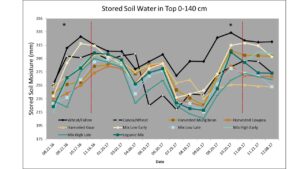
Vernon
The site at Vernon had irrigation capabilities, and up to one inch of water was applied to the system during a growing season. Specifically, irrigation was applied at cover crop planting and/or wheat planting to ensure stand establishment in 2016 and 2017. Thereafter, no irrigation was applied. Similar trends in biomass production were observed for early and late termination dates as the on-farm locations, with only one of three years indicating an advantage of a longer growing season on cover crop biomass production. Wheat yields were not different following various termination dates of cover crops and or cover crops vs double crops. In general, wheat yields were variable within treatments, which resulted in no significant differences among treatments. The focus of the Vernon site was the impact on soil properties if sufficient biomass was produced each year. These plots were initiated in summer 2015, thus an additional year of growth had been obtained compared to on-farm locations.
| Treatment | 2016 Biomass lb/ac | 2017 Biomass (lb/ac) | 2018 Biomass (lb/ac) | 2017 Wheat Yield (bu/ac) | 2018 Wheat Yield (bu/ac) | 2019 Wheat Yield (bu/ac) |
| Mixture - Early Termination | 5902 | 4527 | 4863 | 28.7 | 13.9 | 29.2 |
| Mixture - Late Termination | 6126 | 7693 | 3683 | 27.0 | 11.8 | 52.2 |
| Mixture - Hay | 6910 | 6988 | 5416 | 23.9 | 13.3 | 50.3 |
| Cowpea Double Crop | 259* | 106* | 516* | 30.2 | 5.5 | 41.8 |
| Cowpea Cover Crop | 5307 | 6020 | 3386 | 26.6 | 8.4 | 39.5 |
| Mung Bean Double Crop | 155* | 931* | 321* | 20.2 | 8.0 | 54.0 |
| Mung Bean Cover Crop | 3604 | 5137 | 3333 | 21.9 | 10.3 | 28.5 |
| Fallow | - | - | - | 20.5 | 10.7 | 47.4 |
| * Grain Yield | ||||||
As observed at the Wilbarger County location, stored soil water content was affected by treatment. Cover crops and double crops use stored soil water during peak growth periods. However, stored soil water content was similar among all treatments at wheat planting. In some cases, soil water content was higher due to cover crop or double crop treatments after wheat emergence. Cornell sprinkle infiltrometers were used at this location, but did not show significant differences among treatments during the spring. However, trends showed improved infiltration over the summer fallow treatment, particularly for the mixed species cover crops and the mung bean cover crop. The lasting residue of the grasses within the mixture may prove beneficial in water capture and infiltration in the long-term.
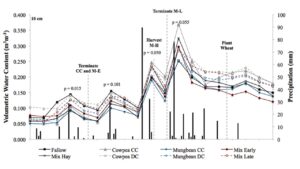
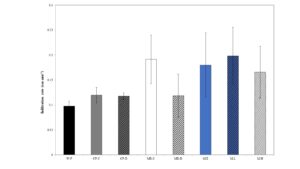
Increase awareness of soil health also increased the awareness of soil biological function and activity in the soil. As a result, laboratories focusing on microbial analysis are more common. Phospholipid fatty lipd analysis is an analysis offered by laboratories focusing on soil health. While costs are higher than traditional testing, demand for such testing justify the costs. The below table shows total PLFA, total bacteria, total fungi, and total arbuscular mycorrhizal fungi (AMF). Results varied by date and within microbial community. Significant differences were observed for the August 2018 date for total PLFA and total bacteria biomass, and for the Non 2018 date for total fungi and AMF. Numerically, the summer fallow treatment resulted in the lowest total PLFA, bacteria, and AMF for each of the above dates. The mixed species cover crops, cowpea cover crops and double crops, and mung bean cover crop and double crop had higher total PLFA and bacteria than the summer fallow treatment. Only the hayed mixed treatment did not differ from the summer fallow treatment.
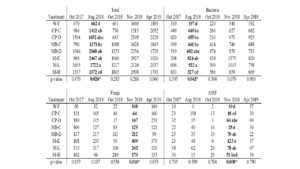
The below figure demonstrates the impact of cover crops versus double crops on microbial parameters and active carbon. When observing the data based upon same species grouping, the double crop tended to have numerically higher values than the cover crop. For example, a double crop cowpea had higher values than a cover crop cowpea or a early terminated cover crop had lower values than a late terminated cover crop. Hence, active root/plant growth could lead to greater microbial activity and biomass and higher active carbon pools.
Education
Our main form of education is conducted through workshops and field days as well as cooperating producers actively engaging and hosting stakeholders at these and other educational forums. Our signature event was bust tour of all four locations in August 2018. This also coincided with the time of the most intense drought during the project period and occurred on a day with temperatures over 100 oF. However, the feedback from the producers was positive. Some noted the appreciation of observing treatment effects under harsh conditions, allowing them to observe the viability of different species. There was a great interest in grazing potential of summer crops, which was not evaluated in this project. The feedback from the survey provided during the tour is available at the following link Evaluation.
Educational & Outreach Activities
Participation Summary:
Findings of this projected were presented at several conferences and/or workshops.
DeLaune, P.B. 2017. Agronomic and economic evaluation of cover crops. Red River Crops Conference, Childress, TX. 24-25 January 2017. (127 attendees)
DeLaune, P.B. 2017. Enhancement of water resources with intensified cropping systems. Soil Health Short Course. Wichita Falls, TX. 22-23 February 2017. (254 attendees)
DeLaune, P.B. Cover crops – pros and cons. 2017. Wichita Falls, TX. Wichita Falls Farm & Ranch Show. 8 March 2017. (100+ attendees)
DeLaune, P.B. and S. Bevers. 2017. Agronomic & Economic evaluation of cover crops. Crowell, TX. Foard County Cover Crop Program. 1 June 2017. (20 attendees)
DeLaune, P.B., P. Mubvumba, and E. Kimura. 2018. Double cropping vs. cover cropping in North Texas wheat systems. Southern Branch ASA Meetings. Jacksonville, FL. 4-6 February. (65 attendees)
DeLaune, P.B., P. Mubvumba, K.L. Lewis, and T.J. Gentry. 2018. Impact of zero-till on soil properties and function in subtropical Texas, USA. 21stWorld Congress of Soil Science. Rio De Janeiro, Brazil. 12-17 August. (40 attendees)
DeLaune, P.B. 2018. The benefits of cover crops. Texas Ag Industries Association Salado Regional Meeting. Belton, TX, 4 October 2018. (45 attendees)
DeLaune, P.B., P. Mubvumba, M. Schirmacher, S. Park, E. Kimura, and T. Gentry. 2018. Intensified cropping systems for soil health and economic viability. ASA-CSSA-SSSA International Meetings. Baltimore, MD. 4-7 November 2018. (50 attendees)
Schirmacher, M., P. DeLaune, T. Gentry, P. Mubvumba, and E. Kimura. 2018. Impacts of cover cropping versus double cropping on soil moisture and crop yield of no-till winter wheat systems in the Texas Rolling Plains. ASA-CSSA-SSSA International Meetings. Baltimore, MD. 4-7 November 2018. (1stPlace graduate student poster competition).
DeLaune, P.B., T.J. Gentry, and K.L. Lewis. 2018. Intensifying semi-arid cropping systems to improve soil condition. Soil Security and Planetary Conference. Sydney, Australia. 4-6 December 2018. (85 attendees)
Schirmacher, M., P. DeLaune, T. Gentry, P. Mubvumba, and E. Kimura. 2018. Enhancing soil health and wheat yields with intensive summer fallow management. Texas Plant Protection Conference. College Station, TX. 4-5 December 2018.
Schirmacher, M., P.B. DeLaune, T.J. Gentry, P. Mubvumba, and T.W. Boutton. 2019. Impacts of cover versus double cropping on soil health in Texas no-till wheat systems. SSSA International Soils Meeting. San Diego, CA. 6-9 January 2019.
Schirmacher, M., P.B. DeLaune, T.J. Gentry, and P. Mubvumba. 2019. Soil health benefits of intensifying winter wheat systems. Southern Branch ASA Meetings. Birmingham, AL. 3-5 February 2019.
DeLaune, P.B. 2019. Improving soil function with intensified cropping systems. 2019. Soil Survey & Land Resource Workshop. College Station, TX. 7-8 February 2019. (60 attendees)
Schirmacher, M., P. DeLaune, T. Gentry, and P. Mubvumba. 2019. Soil health and yield benefits of intensifying winter wheat systems. Soil Survey & Land Resource Workshop. College Station, TX. 7-8 February 2019. (1stPlace Student Oral Competition)
DeLaune, P.B. 2019. Examining cover crop benefits in continuous wheat and cotton rotations in a semi-arid environment. 2019 National Cover Crop Summit (Webinar). 20-21 March 2019. (3500 registrants from 50 countries).
Schirmacher, M., P. DeLaune, T. Gentry, and P. Mubvumba. 2019. Alternatives to summer fallow in continuous wheat systems. National Sustainability Summit and National Extension Energy Summit. Tampa, FL. 16-19 April 2019.
Learning Outcomes
No-till implementation and management
Cover crop termination timing
Residue management
Legume forage species
Soil water dynamics
Alternative summer crops
Below ground soil/root dynamics
Soil health
Cover crop species selection
Project Outcomes
This project demonstrated potential soil health promoting practices in water limited environments of the Texas Rolling Plains that can be extrapolated to similar regions and systems.
Continuous wheat systems have degraded soil resources, along with declining wheat commodity prices, economic risks have increased for grain-only continuous wheat systems. Cover crops have several health promoting benefits, but concerns arise over potential water use that could be detrimental to subsequent wheat yields. Results from this project showed the following:
Cover crops can be produced to provide biomass that can provide protective residue;
Double crops provide similar soil health benefits as cover crops;
Soil water deficits may be expected with cover crop and/or double crop use; however, soil water is recharged more rapidly with cover crop residue and deficits are resolved by time of cash crop planting in normal precipitation years;
Lower cover crop seeding rates may be considered to provide protective residue and soil health benefits;
Earlier termination of cover crops can reduce the risk of of soil water deficits in drier years, although lasting residue will be diminished compared to cover crops terminated at later maturity stages;
Legume cover crops and double crops provide N benefits, but little lasting residue;
A cover crop mixture consisting of grasses and legumes can provide a balanced C:N ratio and lasting residue;
Longer growing cover/double crops trended toward increased microbial biomass, infiltration rates, and active carbon levels;
Through discussion, farmers noted the increased awareness of soil health and benefits of cover crops from non-traditional farmers.
Farmers appreciated the opportunity to see several treatment options within farmer fields, although a small scale was used. This was discussed with an advisory panel prior to proposal submission. While on-farm large scale demonstrations are important and useful, limited management practices can be evaluated. Grazing potential of cover crops should be considered in the future, perhaps using a combination of large and small scale demonstrations.
